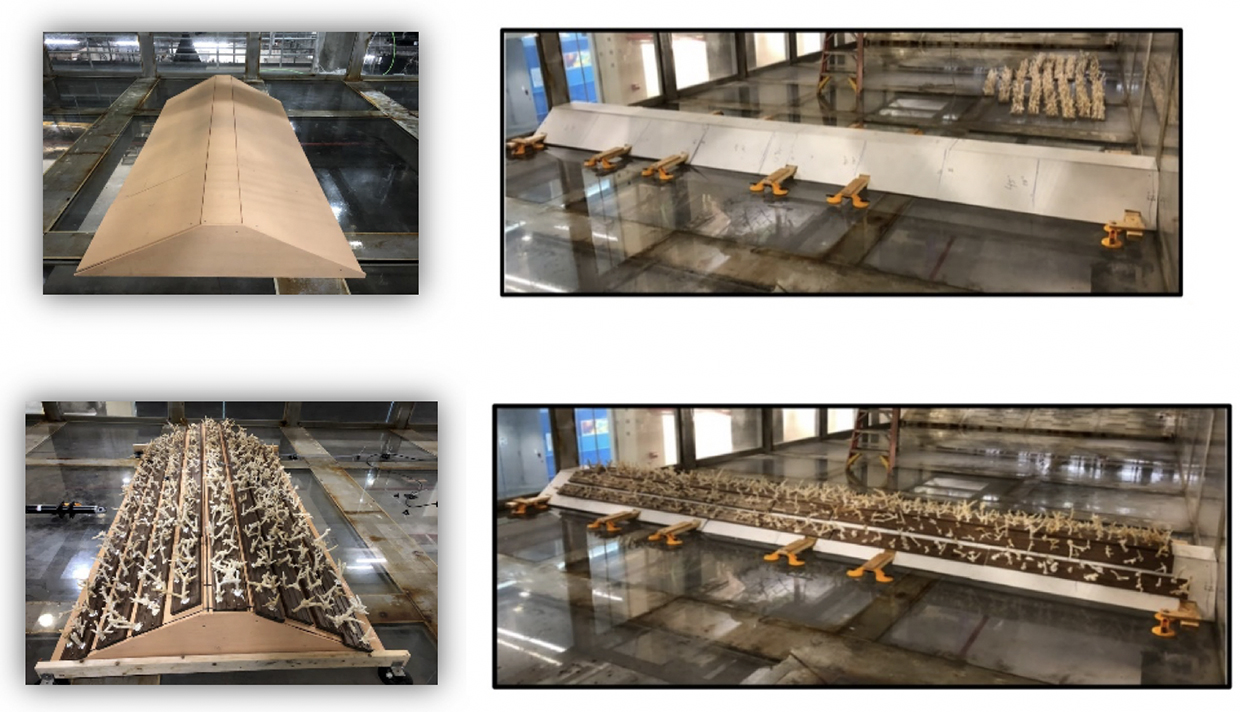IDEA Project NCHRP-213: SEAHIVE – Sustainable Estuarine and Marine Revetment PI: Landolf Rhode-Barbarigos, UM CAE
PI: Landolf Rhode-Barbarigos, UM CAE
Summary
Coral reefs function as submerged breakwaters reducing wave action and providing flood-reduction benefits for coastal communities. Although the wave-reducing capacity of coral reefs has been associated with wave breaking and friction, quantifying the contribution of corals in their wave-energy dissipation mechanisms remains a challenging topic. In the absence of universally accepted guidelines for employing artificial coral reefs for coastal protection and a lack of direct measures of their effects in wave energy at relevant scales, a series of experiments at the University of Miami’s Surge-Structure-Atmosphere-INteraction (SUSTAIN) Facility were conducted on a trapezoidal reef model with and without corals to evaluate the impact of corals on the wave-reducing capacity of the reef. It is shown that the artificial coral reef has a higher wave-reducing capability compared to its corresponding breakwater model (reef without corals). However, the influence of corals varies according to the testing conditions. The wave-energy reduction obtained overall by the artificial coral-reef model depends on the hydrodynamic conditions and geometrical characteristics of the system with the reduction being proportional to the structure height (in shallow water conditions) as well as the incident wave amplitude and wavelength. Exploring these experimental results can guide the design of artificial coral reefs for coastal protection.
Introduction
As natural threats for coastal communities such as tropical storms and hurricanes continue to exacerbate by climate change, the need for reliable, cost effective and sustainable solutions that mitigate their destructive effects increases. Wave attack represents a major coastal damage mechanism. Waves can impact the integrity of structures especially on their seaward face and/or cause scouring at their toe. They can also lead to overtopping which increases flooding. Reducing wave impacts in coastal communities is thus critical.
Coral reefs provide significant protection against waves (Ferrario et al, 2014). They act as low crested submerged breakwater structures reducing wave height and dissipating wave energy through wave breaking and friction (Beck et al, 2018). Although significant research has been conducted on the wave-energy dissipation from coral reefs and their protection to the built environment and coastal infrastructure (Van Zanten et al, 2014), direct measures of the reduction in wave energy induced by coral reefs are lacking at relevant scales. Moreover, quantifying the contribution of corals in wave-breaking and frictional effects is a challenging task, albeit necessary for the consideration of artificial coral reefs as shoreline-protection systems. Therefore, there are currently no widely accepted design guidelines for artificial coral reefs. This study aims thus to assess the wave-reducing capacity of coral reefs quantifying the impact of corals on wave-height attenuation and consequently wave-energy dissipation through physical testing at the SUrge STructure Atmosphere INteraction (SUSTAIN) Facility at the University of Miami.
Description of the experiments
The experiments for the evaluation of the wave-reducing capacity of coral reefs and the quantification of the impact of corals were conducted in SUSTAIN which provided the ability to carry out physical testing at relatively large scales (Fig. 1) providing a unique platform for the quantification of the effects contributing in the wave-energy dissipation occurring from an artificial coral reef.
In this study, in order to assess the wave-reducing capacity of coral reefs and quantify the impact of corals on wave-energy dissipation, a physical model of an artificial coral reef was tested with and without corals on top of it. A typical breakwater was used as reference for the construction of the model considering a geometric scale factor of 1:5. The dimensions of the prototype reef structure were driven by a prospective field deployment along the shore of Miami Beach. The model was made out of wood with the breakwater substructure having a trapezoidal cross section with a 1:1 forereef slope, a height (bottom of the flume to the reef flat) of 30 cm, a horizontal reef flat of 30 cm length, and a 1:1.73 backreef slope. For the configuration with the corals, staghorn coral skeletons with an average height of 10 cm were added on the model. The model spanned across the width of the SUSTAIN tank to avoid flow changes at ends impacting water level measurements and thus wave-height and energy calculations.

The submerged breakwater without corals (top) and with corals (bottom)
Related paper: Ghiasian,M., J. Carrick, L. Rhode-Barbarigos, B. Haus, A. C. Baker, D. Lirman, “Dissipation of wave energy by a hybrid artificial reef in a wave simulator: implications for coastal resilience and shoreline protection” Limnology and Oceanography:Methods, 2020, doi: 10.1002/lom3.10400/




